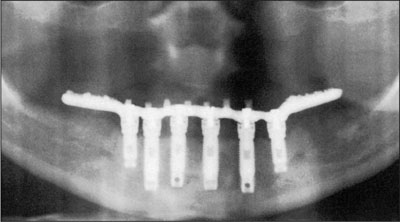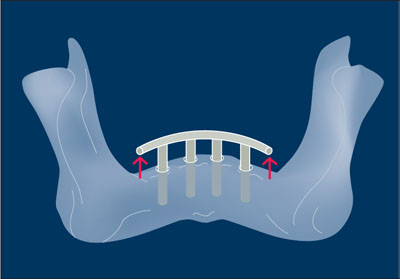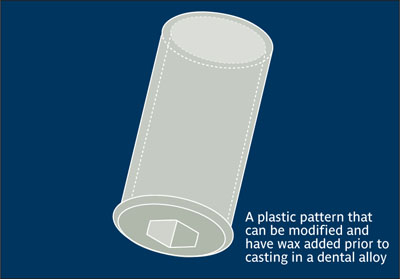C
CAD/CAM Acronym for computer-aided design/ computer-assisted manufacture. See: Computer-aided design/Computer-assisted manufacture (CAD/CAM).
CAD/CAM abutment Prosthetic implant component fabricated through the use of computer-aided design and/or computer-assisted manufacture (CAD/CAM).1
Calcified algae Plants living in seawater, some in deep water, that are coral shaped with mineralized cell walls. Corallina officinalis (coral algae), used for the production of porous marine-derived coralline hydroxyapatite, is approximately 5 cm in height with built-in joint and belongs to the red algae group. See also: Porous marine-derived coralline hydroxyapatite.
Calcified cartilage See: Endochondral ossification.
Calcium carbonate See: Porous coralline hydroxyapatite.
Calcium sulfate Used in bone regeneration as an alloplastic graft, a graft binder, or a graft extender, and as a barrier. This biocompatible material (CaSO4) resorbs following implantation. It has been shown that tissue will often migrate over calcium sulfate if primary closure cannot be obtained. Calcium sulfate has been proposed as a delivery vehicle for growth factors and antibiotics.2-4 See also: Medical-grade calcium sulfate; Dental stone.
Calculus Hard concretion that forms on teeth or dental prostheses through calcification of bacterial plaque.5
Caldwell-Luc approach Surgical approach using a window into the buccal bone wall of the maxillary sinus. The goal is sinus floor elevation to allow simultaneous or subsequent implant placement in sites with insufficient bone height.
Callus Hard bony tissue that develops around the ends of a fractured bone during healing.6
Callus distraction Basis for distraction osteogenesis in orthopedic surgery. See also: Distraction osteogenesis (DO).
Calvarial bone See: Cranial bone.
Calvarial bone harvest See: Cranial bone harvest.
Calvarial graft See: Cranial bone harvest.
Canaliculus Minute canal extendig to the lacunae of bone See: Osteocyte.
Cancellous bone Composite of bone matrix and bone marrow. Osteoblasts, osteoprogenitor cells, and cytokines are transferred. Also used to describe a graft derived from cancellous bone, which is a spongy type of bone containing a trabecular structure with red bone marrow and most of the bone vasculature. See also: Trabecular bone.
Cancer See: Neoplasm.
Cancer reconstruction Tumor resection of the jaws often leads to discontinuity defects that need extensive bone reconstruction and restoration with implant-supported prostheses.
Canine guidance See: Canine-protected articulation.
Canine-protected articulation Arrangement of teeth in which the vertical and horizontal overlap of the canines provide a guidance resulting in separation of the posterior teeth during eccentric movements of the mandible.7
Cantilever Extension on one end of a fixed prosthesis retained by single or multiple teeth or implants. Also used to describe a beam supported at one end only.7,8

Cantilever.

Cantilever.
(Reprinted from Watzek9 with permission.)
Capillary Small terminal blood vessel connecting arterioles and venules.
Cartilage-derived morphogenetic protein 1 (CDMP1) Protein belonging to the transforming growth factor beta (TGF-β) superfamily involved in a variety of cellular functions. This molecule has been identified as one of the regulators of limb skeletogenesis and appendicular bone development.10 See also: Transforming growth factor beta (TGF-β).
Case report Descriptive study of either a single patient or patient series that documents the patient’s diagnosis, treatment, and management.11,12
Cast Three-dimensional image of an actual body part reproduced in a castable material.2,13 See also: Diagnostic cast; Master (definitive) cast; Preliminary cast.
Castable abutment Prosthetic implant component made as a generic plastic pattern that can be designed or modified to specific dimensions. The pattern can be modified either by shaping via a rotary carbide bur or applying wax prior to alloy casting.

Castable abutment.
CAT Acronym for computed axial tomography. See: Computed tomography (CT) scan.
Cawood and Howell classification Classification of patterns of jaw bone atrophy serving to simplify description of the residual ridge. In the study published in 1988, it was found that the shape of the basilar process of the mandible and maxilla remains relatively stable, whereas changes in shape of the alveolar process are significant in both the vertical and horizontal axes and follow a predictable pattern.14 See also: Alveolar ridge, Classification of.
CBA Abbreviation for Cost-benefit analysis.
CBFα1 Abbreviation for Core-binding factor alpha 1.
CDMP1 Abbreviation for Cartilage-derived morphogenetic protein-1.
CEA Abbreviation for Cost-effectiveness analysis.
Cell Microscopic mass of protoplasm enveloped by a semi-permeable membrane. Smallest structural unit of living matter able to function independently. See also: Erythrocyte; B cell; Blood cell; Bone cell; Effector cell; Epithelial cell; Hematopoietic stem cell; Mesenchymal stem cell (MSC).
Cell-occlusive membrane See: Barrier membrane.
Cellular process All of the functions that cells perform to survive, including molecular transport, protein synthesis, DNA replication, reproduction, respiration, cellular metabolism, and signaling.
Cement Substance used to bind surfaces or objects together. Commonly stored as separate powder and liquid components that, when mixed together, become a luting agent upon hardening.To cement is to join surfaces by means of an appropriate medium.2,3
Permanent c. Binding or luting agent intended for long-term use, eg, zinc phosphate cement, which is composed of powder (zinc and magnesium oxides) and liquid (phosphoric acid, water, buffer agents). Other types include resin and glass-ionomer cements.
Temporary c. Binding or luting agent intended for short-term use, eg, zinc oxide (powder) eugenol (liquid) mixture.
Cement line Inactive bone surfaces are covered by a thin-density, stained 50-nm-thick line, consisting of a mineralized bone matrix in which the inorganic component is hydroxyapatite and the organics are proteoglycans and glycoproteins, with osteopontin as the major glycoprotein. The same line is apparent between implant surfaces and adjoining bone. Osteopontin functions as an adhesive and, in bone, binds collagen fibrils of new bone matrix to that of the old bone matrix.
Cementation Process involving the use of a binding substance to join surfaces to become a unit.2
Centric See: Centric occlusion; Centric relation; Maxillomandibular relationship.
Centric occlusion Positional relationship of occluding tooth surfaces when the mandible is in centric relation. The coincidence of centric occlusion and centric relation is desirable when creating an occlusion, but the maximal intercuspal relationship may not always exist.3,15 See also: Maxillomandibular relationship.
Centric relation Clinically, the most retruded unstrained position of the mandibular condyles relative to the maxilla, from which lateral movements can be made at a given degree of jaw separation. Centric relation is a reference border position constant throughout life for each adult patient, provided the soft tissue structures in the temporomandibular joint are healthy. It is a reference relation from which a planned occlusal scheme can be coordinated.16 See also: Maxillomandibular relationship.
Ceramic Crack-, heat-, and corrosion-resistant material fabricated from metal oxides of various sources. Also describes a field of research concerned with ceramic materials. See also: Bioactive glass; Glass ceramic.
Ceramic abutment Prosthetic implant component composed of a ceramic biomaterial that is considered an esthetic material as compared to unesthetic metal. The ceramic material used in fabrication of a prosthetic implant component varies as does the fabrication method of various manufacturers, which can include use of CAD/CAM technology.17,18
Ceramic crown One type of ceramic restoration. See also: Ceramic restoration; Crown.
Ceramic restoration Artificial substitute for tooth structure and anatomy fabricated entirely of ceramic material that covers and restores the remaining coronal portion of the tooth.
Cervix (pl: cervices) Constriction or narrowing of an object; sometimes referred to as the neck.19 See also: Implant neck.
Chamfer Marginal tooth crown or implant abutment preparation creating a curve from the axial wall to the cavosurface.3
Chemotaxis Directed cell migration controlled by a biochemical concentration gradient.
Chemotherapy Use of chemical agents in the treatment or control of malignant disease. Patients undergoing chemotherapy are considered at high risk to develop postsurgical complications following implant placement.
Chewing See: Mastication.
Chewing cycle See: Mandibular movement.
Chin graft See: Bone graft, Donor site for.
Chisel Metal instrument with a tip that is beveled one side. Used in surgery to cut, cleave, or carve hard tissue. The shank can be straight or offset.2
Chi-square test Determines whether two attributes of the sample are independent or whether the presence of one is, in fact, associated with the presence of the other.12
Chlorhexidine Antibacterial compound (C22H30Cl2N10) that is a biguanide derivative used as a local antiseptic and disinfectant (eg, as in mouthwash) especially in the form of a hydrochloride, gluconate, or acetate.
Chondrocyte Mature cartilage-forming cell embedded in cartilage. Highly specialized connective tissue designed to withstand high compressive forces. Cartilage is nourished via diffusion. In endochondral ossification, the chondrocytes undergo apoptosis associated with vascularization, bone formation, and resorption of cartilage.
Chondroitin sulfate Plays a major role in maintaining the high osmotic tension essential to the elasticity of hyalin cartilage. Hyalin cartilage is composed of collagen type II that forms a meshwork, enclosing giant macro-molecular aggregates of proteoglycans. Chondroitin sulfate is a main part of this ground substance.
Chronic abscess Abscess of comparatively slow development with minimal evidence of inflammation. Symptoms include intermittent discharge of purulent matter and longstanding collection of purulent exudate. May follow an acute abscess. Compare: Residual abscess.
Chronic infection Ongoing and often slowly progressing infection. Usually develops from an acute infection and can last for days to months to a lifetime.
Cicatrix See: Scar.
Circulation, blood General term for blood supply and flow through blood vessels, organs, and tissues.
Clamp, abutment See: Abutment clamp.
Clamping force Compressive force generated by bringing two distinct components together under pressure. It is created by external compressive forces or the tightening of a screw joint.
Cleft lip and/or palate
Stay updated, free dental videos. Join our Telegram channel

VIDEdental - Online dental courses


